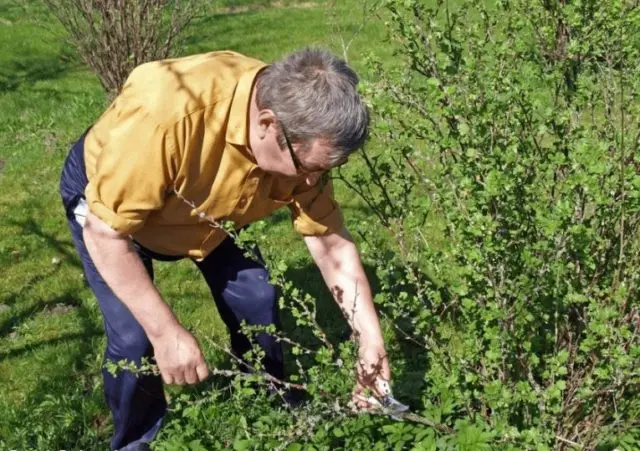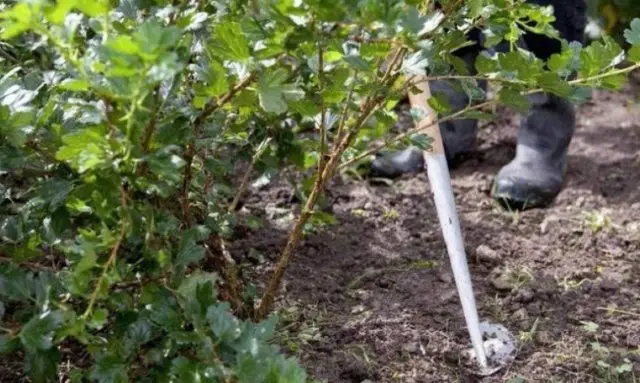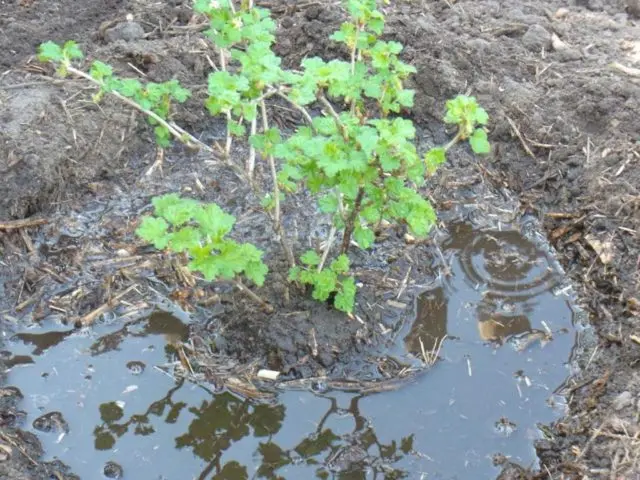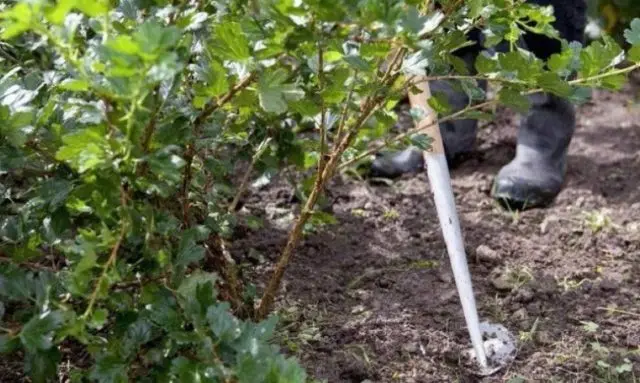Contents
Proper care of gooseberries after harvesting plays a big role in the subsequent growth and development of the plant. It allows you to restore the forces spent on fruiting, and also prepares plantings for the cold. It is during this period that gooseberries need special care.

What to do with gooseberries after picking berries
Harvesting is carried out in late August or early autumn, depending on the characteristics of a particular variety. Proper care of gooseberries after picking berries is the key to health and abundant fruiting for the next year. All necessary work must begin immediately after picking the berries. Care during this period includes the following steps:
- Weeding the soil under the bushes, cleaning old leaves and plants, loosening.
- Abundant watering in accordance with a specific schedule.
- Application of mineral and organic fertilizers.
- Pruning old and damaged shoots.
- Preventive treatment of bushes from diseases and parasites.
- Mulching the soil under the gooseberry.
How to care for gooseberries after harvest
Caring for gooseberries after harvesting has its own characteristics. Compliance with certain rules will allow the plant to replenish the forces spent during the season.
Sanitary pruning
Immediately after the end of the fruiting season, experienced gardeners do not recommend pruning the bushes. This can lead to the development of young shoots that simply do not have time to get strong enough before the onset of frost to survive the winter.
Pruning is done after all the foliage has fallen, usually in mid-autumn. The purpose of this event is to remove excess branches that can harm the plant. Branches for pruning are selected according to the following criteria:
- broken, damaged;
- zasohšie
- old, with dark bark;
- thin, undeveloped;
- growing towards the inside of the bush;
- lower shoots lying on the ground;
- with traces of damage by diseases or pests.
To properly cut gooseberries, you should follow a number of simple rules:
- Pruning is done with a lopper or long-handled secateurs, this will avoid injections on the gooseberry thorns.
- Thick gloves are used for additional hand protection.
- Unnecessary branches are cut out entirely, leaving no hemp.
- In young healthy branches, which are shortened to enhance branching, an incision is made over a strong bud.

Cleaning and digging the root zone
The very first thing that needs to be done with gooseberries after harvesting is to collect fallen leaves, fallen berries, and broken branches from under the bushes. If traces of a fungal infection are visible on the collected leaves and fruits, they must be burned so that the disease does not spread to healthy crops. If there are no signs of illness, they can be used as humus.
You also need to weed the weeds under the gooseberries so that they do not take nutrients from the roots of the plant and do not deplete the soil. Small weeds can simply be pulled out, and large ones can be dug along with the rhizome. The green part of pest plants can be scattered under the bushes, they will play the role of organic fertilizer.
After that, the soil must be dug up. This will help get rid of pests and possible fungal spores, and will also saturate the earth with oxygen. The soil should be loosened carefully, to a depth of no more than 6-7 cm, so as not to damage the gooseberry roots.
Watering schedule and rules
Gooseberries, unlike other berry bushes, do not need regular watering. But still, after the completion of fruiting, the plant should not experience a lack of moisture. If the gooseberry hibernates with dry roots, this can lead to the death of the bush.
In this case, you need to focus on the amount of precipitation: in a rainy autumn, additional watering may not be needed, but if the weather is dry, the gooseberries should be moistened.
Watering is carried out in several visits. At one time, 4-5 buckets of water are poured under each bush. The soil should be moistened by at least half a meter, since the gooseberry roots are deep enough. Watering is done 3-5 times depending on the amount of precipitation.
To avoid the development of fungal diseases, some gardeners resort to a special method of watering: they dig a groove along the perimeter of the crown and pour 2-4 buckets of water into it. After the water has been absorbed, the groove is sprinkled with a layer of earth.

How to feed gooseberries after fruiting
Caring for gooseberries after picking berries includes fertilizing. Nitrogen-containing top dressings should not be used, as they can become a catalyst for the growth of new branches that will not have time to get stronger before the onset of cold weather.
In the post-harvest period, the following mineral fertilizers can be used:
- 2 tablespoons of superphosphate in a bucket of water;
- a glass of ash and a tablespoon of superphosphate in a bucket of water.
Organic supplements will also be useful:
- dry wood ash at the rate of 100-150 g per 1 sq. m. soil;
- a bucket of humus or peat per 1 gooseberry bush (after making the soil should be well loosened);
- mullein infusion is diluted in half and watered at the rate of a bucket per 1 gooseberry bush.
If fertilizers are applied in a dry form, it is necessary to water the ground under the gooseberries after top dressing.
You can also use foliar top dressing: treatment with growth and immunity stimulants. This is especially important for bushes with a large number of berries, which have spent a lot of effort during the fruiting season.
Processing gooseberries after fruiting
The time after harvest is the most suitable for the preventive treatment of gooseberry bushes from pests and various diseases. If there are no signs of damage on the plant, then it is enough to carry out a single treatment in October. If signs of illness are noticeable, then the treatment can be repeated again at the end of autumn.
Care consists in treatment with a solution of Bordeaux mixture, Fundazol or other antifungal agents that can be purchased in specialized stores.
You can also spray the bushes after picking berries from the most common pests that threaten plantings: mites, glass cases, gall midges. To do this, use drugs such as Karbafos, Lepidicide, Fitoverm, etc.

Mulching the root zone
After harvesting, it is also necessary to protect the gooseberry roots from the upcoming cold weather. To maintain the porosity of the soil, mulching is carried out. As a material for this, you can use:
- dry leaves mixed with humus;
- peat;
- pine needles;
- sawdust;
- special covering material.
Mulch is laid around the gooseberry trunk with a layer of 10-15 cm. In the spring, you need to remember to remove the mulch layer and loosen the soil properly.
Conclusion
Gooseberry care after harvest is an important component of abundant fruiting in subsequent years. It includes loosening the soil under the shrub, watering and fertilizing with mineral and organic fertilizers, preventive treatment, and mulching. Compliance with the recommendations for care will allow the gooseberry to quickly restore strength and prepare it for the upcoming frosts.









